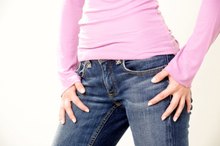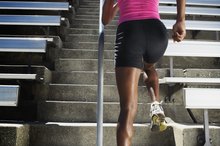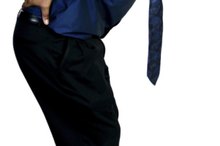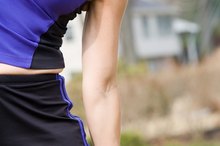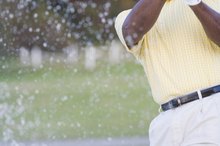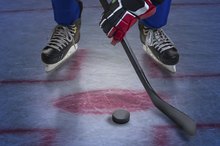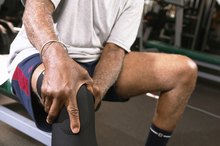Causes of Hip Pain in a 35 Year Old Female
According to the American Academy of Family Physicians, athletes in certain sports are particularly prone to hip injury, especially those involved in track or other running sports, soccer and dancing 23. Generally, most hip pain occurring in women in their 30s will be the result of muscle, tendon or bursa irritation and will respond favorably to activity modification, ice and stretching.
If you are experiencing serious medical symptoms, seek emergency treatment immediately.
Bursitis
A bursa is a sac-like structure filled with a thick gel that is usually found between a joint and its overlying tissue. A bursa functions to reduce friction as the muscles and tendons repeatedly cross over a joint. In the hip joint, irritation of the bursa is known as trochanteric bursitis. According to the American Academy of Orthopaedic Surgeons, hip bursitis can affect anyone, but is more common in women and middle-aged or elderly people and is less common in younger people and in men 23. Hip bursitis can be caused by an activity such as running, or can develop without any apparent provocation. Pain from bursitis is typically worse at night, especially when lying on the involved side.
- A bursa is a sac-like structure filled with a thick gel that is usually found between a joint and its overlying tissue.
- Hip bursitis can be caused by an activity such as running, or can develop without any apparent provocation.
Iliotibial Band Syndrome
Causes of Bilateral Hip Pain in Women
Learn More
From the top of the hip crest to below the outside of the knee lies a wide band of connective tissue called the iliotibial band. When this tissue becomes irritated from activities that involve repetitive flexing and extending, it is known as iliotibial band syndrome. This syndrome often affects women who run or cycle long distances and results in pain along the outside of the hip or the knee. According to the American Academy of Family Physicians, after passing over the greater trochanter, the iliotibial band inserts at the knee on the lateral aspect of the tibia, so patients with iliotibial band syndrome may also complain of lateral knee pain 3.
- From the top of the hip crest to below the outside of the knee lies a wide band of connective tissue called the iliotibial band.
- When this tissue becomes irritated from activities that involve repetitive flexing and extending, it is known as iliotibial band syndrome.
Piriformis Syndrome
The large sciatic nerve exits the spine and travels through the sciatic groove and under the piriformis muscle. The piriformis muscle can become tight and press against the sciatic nerve, resulting in radiating pain to the hip and buttock known as piriformis syndrome. According to the American Academy of Family Physicians, females are more commonly affected by piriformis syndrome 3. Symptoms usually consist of a dull ache in the hip, buttock and occasionally down the back of the leg. It is often difficult to distinguish piriformis syndrome from irritation of the sciatic nerve by a herniated disc and a physician may request diagnostic testing before making a diagnosis.
- The large sciatic nerve exits the spine and travels through the sciatic groove and under the piriformis muscle.
- The piriformis muscle can become tight and press against the sciatic nerve, resulting in radiating pain to the hip and buttock known as piriformis syndrome.
Related Articles
References
- The American Academy of Orthopaedic Surgeons: Hip Bursitis
- Cass SP. Piriformis syndrome: a cause of nondiscogenic sciatica. Curr Sports Med Rep. 2015;14(1):41-4. doi:10.1249/JSR.0000000000000110
- Jankovic D, Peng P, Van Zundert A. Brief review: piriformis syndrome: etiology, diagnosis, and management. Can J Anaesth. 2013;60(10):1003-12. doi:10.1007/s12630-013-0009-5
- Bardowski EA, Byrd JWT. Piriformis injection: an ultrasound-guided technique. Arthrosc Tech. 2019;8(12):e1457–e1461. Published 2019 Nov 13. doi:10.1016/j.eats.2019.07.033
- Jankovic D, Peng P, van Zundert A. Brief review: piriformis syndrome: etiology, diagnosis, and management. Can J Anaesth. 2013;60(10):1003-12.
Writer Bio
Based in Connecticut, Jody Murray, has been writing and teaching in the field of sports medicine since 1997. Murray has an M.A. in exercise physiology from UNC-Chapel Hill and a B.S. in athletic training from Springfield College. Murray is also a licensed acupuncturist.
